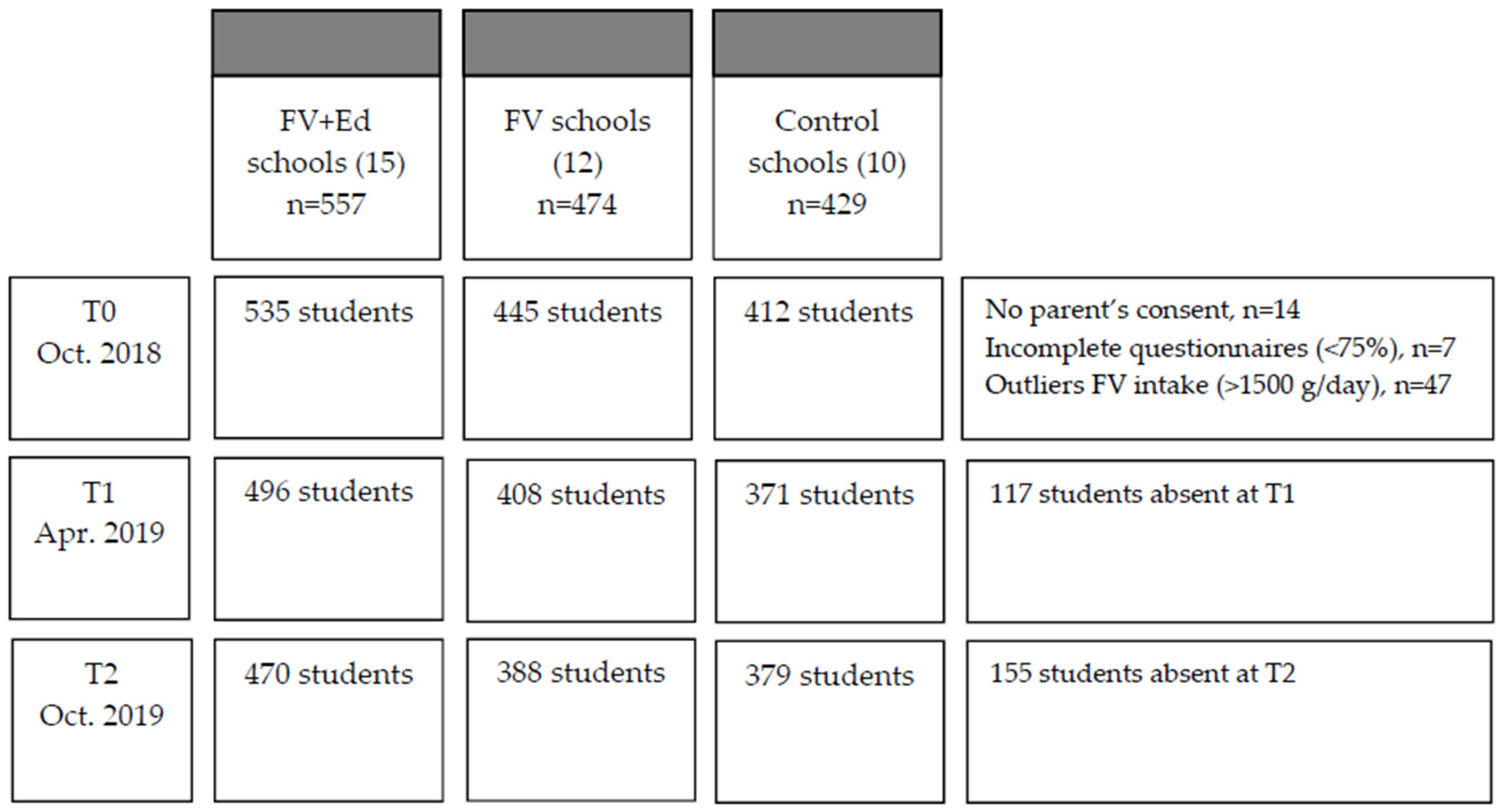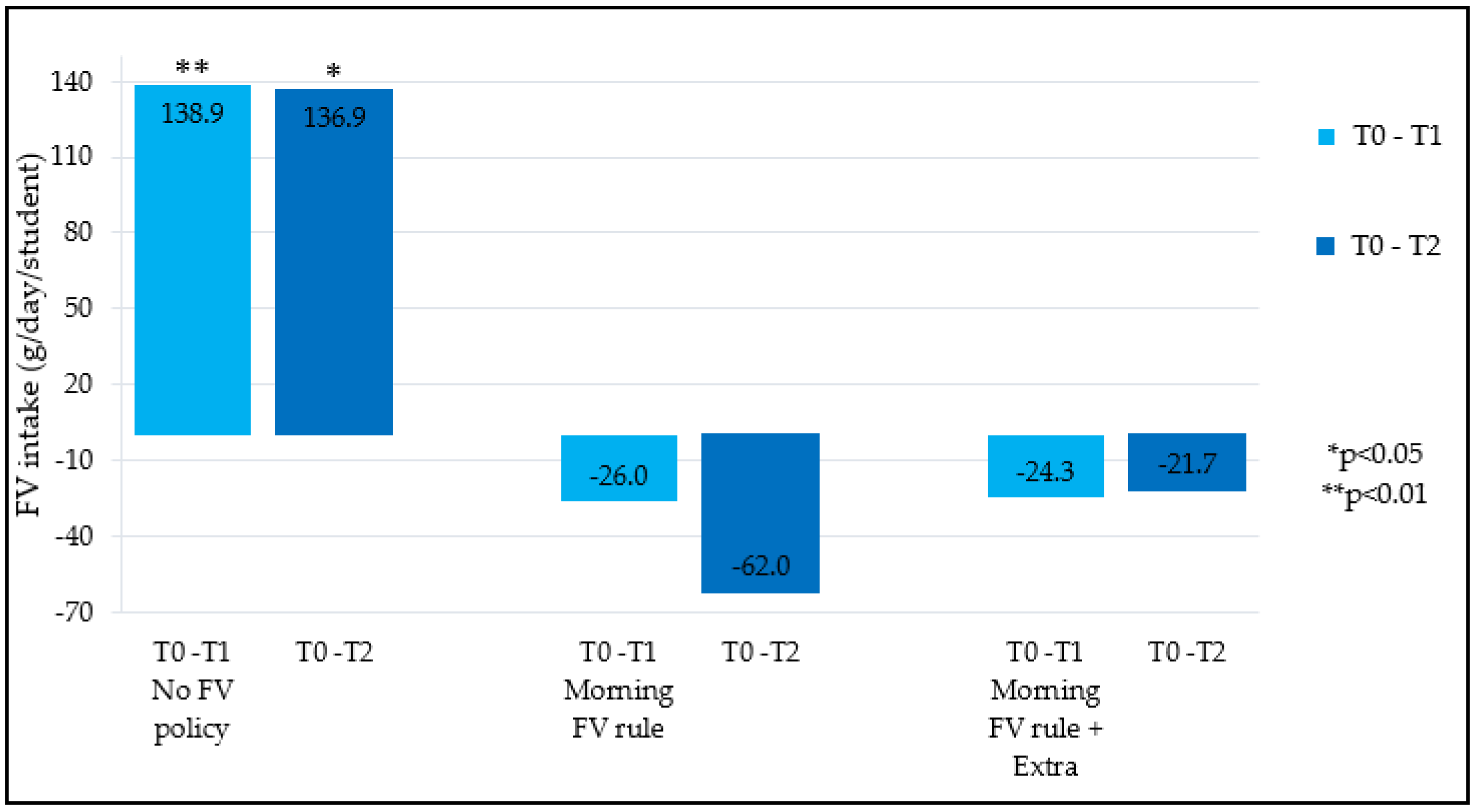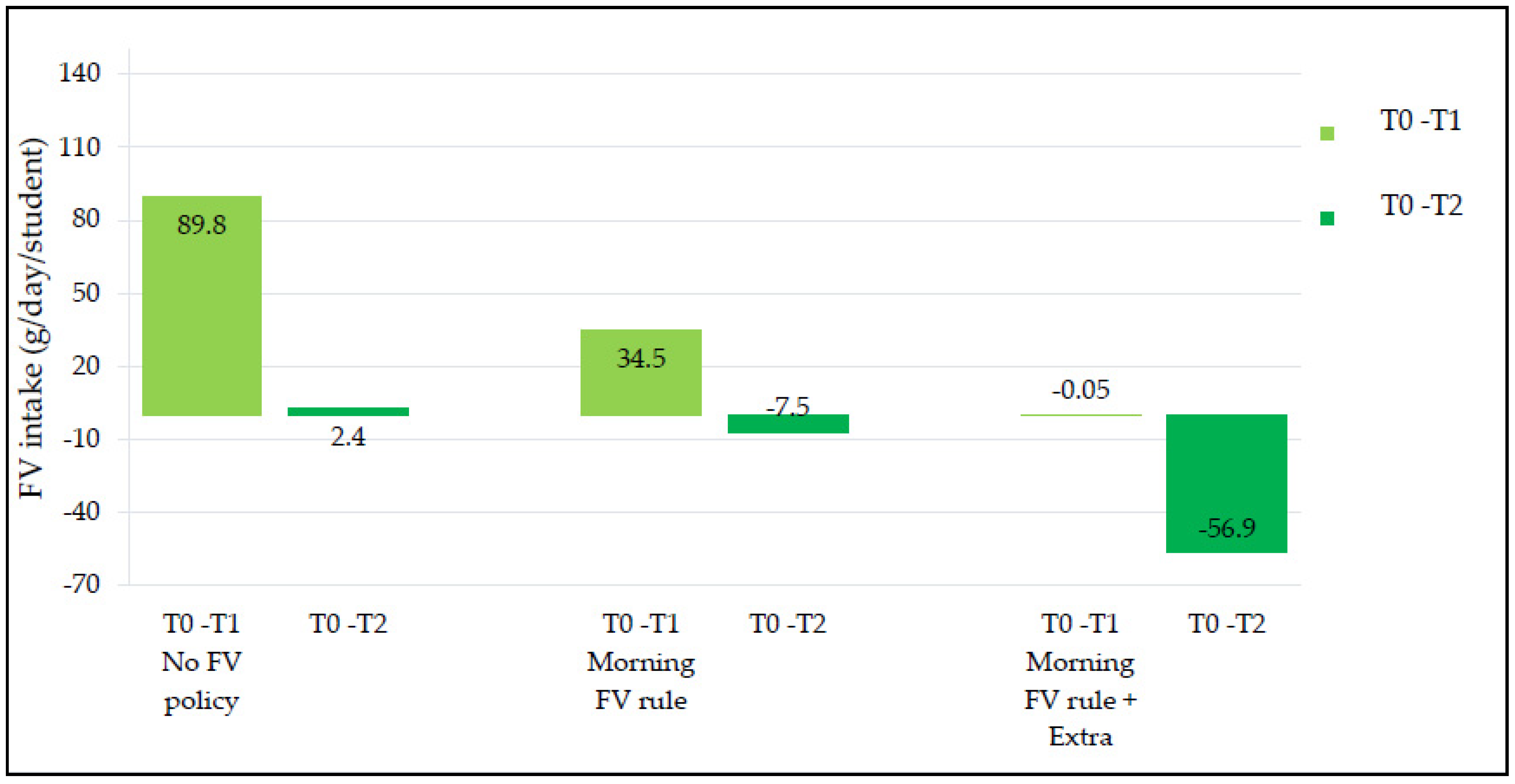Education or Provision? A Comparison of Two School-Based Fruit and Vegetable Nutrition Education Programs in the Netherlands
Abstract
1. Introduction
2. Materials and Methods
2.1. Intervention
2.2. Study Sample and Recruitment
2.3. Study Design and Procedure
2.4. Measures
2.4.1. Outcome Variables
Nutrition Knowledge
Fruit and Vegetable Consumption
2.4.2. Personal Characteristics
2.4.3. Contextual Factors
School Characteristics
School Food Policy
2.5. Statistical Analysis
3. Results
3.1. Demographic Characteristics
3.2. Effect on Children’s Nutrition Knowledge
3.3. Effect on Children’s FV Intake
3.4. Schools Stratified by School Food Policy Status
4. Discussion
4.1. Main Results
4.2. Effect on Children’s Nutrition Knowledge
4.3. Effect on Children’s FV Intake
4.4. Schools Stratified by School Food Policy Status
4.5. Comparison of Different Components
4.6. Strengths and Limitations
5. Conclusions
Author Contributions
Funding
Acknowledgments
Conflicts of Interest
References
- World Health Organization. Increasing Fruit and Vegetable Consumption to Reduce the Risk of Noncommunicable Diseases. 2019. Available online: who.int/elena/titles/fruit_vegetables_ncds/en/ (accessed on 23 June 2020).
- Sotos-Prieto, M.; Bhupathiraju, S.N.; Mattei, J.; Fung, T.T.; Li, Y.; Pan, A.; Willett, W.C.; Rimm, E.B.; Hu, F.B. Association of changes in diet quality with total and cause-specific mortality. N. Engl. J. Med. 2017, 377, 143–153. [Google Scholar] [CrossRef] [PubMed]
- World Health Organization. Healthy Diet. 2018. Available online: https://www.who.int/news-room/fact-sheets/detail/healthy-diet (accessed on 10 February 2019).
- Sahoo, K.; Sahoo, B.; Choudhury, A.K.; Sofi, N.Y.; Kumar, R.; Bhadoria, A.S. Childhood Obesity: Causes and Consequences. J. Fam. Med. Prim. Care 2015, 4, 187. [Google Scholar]
- Craigie, A.M.; Lake, A.A.; Kelly, S.A.; Adamson, A.J.; Mathers, J.C. Tracking of obesity-related behaviours from childhood to adulthood: A systematic review. Maturitas 2011, 70, 266–284. [Google Scholar] [CrossRef] [PubMed]
- Tak, N.I.; te Velde, S.J.; Brug, J. Long-term effects of the Dutch Schoolgruiten Project–promoting fruit and vegetable consumption among primary-school children. Public Health Nutr. 2009, 12, 1213–1223. [Google Scholar] [CrossRef]
- Rosi, A.; Scazzina, F.; Ingrosso, L.; Morandi, A.; Del Rio, D.; Sanna, A. The “5 a day” game: A nutritional intervention utilising innovative methodologies with primary school children. Int. J. Food Sci. Nutr. 2015, 66, 713–717. [Google Scholar] [CrossRef]
- Day, M.E.; Strange, K.S.; McKay, H.A.; Naylor, P.-J. Action schools! BC—healthy eating. Can. J. Public Health 2008, 99, 328–331. [Google Scholar] [CrossRef]
- Hoffman, J.A.; Franko, D.L.; Thompson, D.R.; Power, T.J.; Stallings, V.A. Longitudinal behavioral effects of a school-based fruit and vegetable promotion program. J. Pediatric Psychol. 2010, 35, 61–71. [Google Scholar] [CrossRef]
- Agozzino, E.; Del Prete, U.; Leone, C.; Manzi, E.; Sansolone, N.; Krauss, P.R. Evaluation of the effectiveness of a nutrition education intervention performed by primary school teachers. Ital. J. Public Health 2007, 4. [Google Scholar] [CrossRef]
- Angelico, F.; Del, M.B.; Fabiani, L.; Lentini, P.; Pannozzo, F.; Urbinati, G.; Ricci, G. Management of childhood obesity through a school-based programme of general health and nutrition education. Public Health 1991, 105, 393–398. [Google Scholar] [CrossRef]
- Boaz, A.; Ziebland, S.; Wyke, S.; Walker, J. A’five-a-day’fruit and vegetable pack for primary school children. Part. II: Controlled evaluation in two Scottish schools. Health Educ. J. 1998, 57, 105–116. [Google Scholar]
- Bonaccorsi, G.; Isola, A.; Tognarelli, M.; Lorin, C.; Papini, D.; Lanciotti, E.; Comodo, N. Changes in eating habits among a group of children after completion of an educational intervention program in elementary school. Annali Igiene Med. Prev. Comunita 2002, 14, 243. [Google Scholar]
- D’Addesa, D.; Marzi, V.; Sinesio, F.; Martone, D.; Comendador, F.; Peparaio, M.; Moneta, E.; Cairella, G.; Sonni, L.; Panetta, V. Nutrition intervention to promote higher fruit, vegetable and legume consumption among schoolchildren. Int. J. Obes. 2006, 30, S5–S6. [Google Scholar]
- Dudley, D.A.; Cotton, W.G.; Peralta, L.R. Teaching approaches and strategies that promote healthy eating in primary school children: A systematic review and meta-analysis. Int. J. Behav. Nutr. Phys. Act. 2015, 12, 28. [Google Scholar] [CrossRef] [PubMed]
- Mak, T.; Bonsmann, S.; Genannt, S.; Caldeira, S.; Wollgast, J. How to Promote Fruit and Vegetable Consumption in Schools: A Toolkit. In ACTA Paediatrica; Wiley-Blackwell: Hoboken, NJ, USA, 2016. [Google Scholar]
- Evans, C.E.; Christian, M.S.; Cleghorn, C.L.; Greenwood, D.C.; Cade, J.E. Systematic review and meta-analysis of school-based interventions to improve daily fruit and vegetable intake in children aged 5 to 12 y. Am. J. Clin. Nutr. 2012, 96, 889–901. [Google Scholar] [CrossRef] [PubMed]
- Singhal, J.; Herd, C.; Adab, P.; Pallan, M. Effectiveness of school-based interventions to prevent obesity among children aged 4 to 12 years old in middle-income countries: A systematic review and meta-analysis. Obes. Rev. 2020. [Google Scholar] [CrossRef]
- Micha, R.; Karageorgou, D.; Bakogianni, I.; Trichia, E.; Whitsel, L.P.; Story, M.; Penalvo, J.L.; Mozaffarian, D. Effectiveness of school food environment policies on children’s dietary behaviors: A systematic review and meta-analysis. PLoS ONE 2018, 13, e0194555. [Google Scholar] [CrossRef]
- Cohen, J.F.; Kraak, V.I.; Choumenkovitch, S.F.; Hyatt, R.R.; Economos, C.D. The CHANGE study: A healthy-lifestyles intervention to improve rural children’s diet quality. J. Acad. Nutr. Diet. 2014, 114, 48–53. [Google Scholar] [CrossRef][Green Version]
- Anderson, A.; Porteous, L.; Foster, E.; Higgins, C.; Stead, M.; Hetherington, M.; Ha, M.; Adamson, A. The impact of a school-based nutrition education intervention on dietary intake and cognitive and attitudinal variables relating to fruits and vegetables. Public Health Nutr. 2005, 8, 650–656. [Google Scholar] [CrossRef]
- Rijksinstituut voor Volksgezondheid en Milieu. Centrum Gezond Leven, Loketgezondleven.nl. 2020. Available online: https://www.loketgezondleven.nl/ (accessed on 8 June 2020).
- Van Ansem, W.J.; Schrijvers, C.T.; Rodenburg, G.; Schuit, A.J.; Van de Mheen, D. School food policy at Dutch primary schools: Room for improvement? Cross-sectional findings from the INPACT study. BMC Public Health 2013, 13, 339. [Google Scholar]
- Steunpunt Smaaklessen & EU-Schoolfruit. EU-Schoolfruit. Available online: https://www.euschoolfruit.nl/ (accessed on 7 September 2020).
- Battjes-Fries, M.C.; van Dongen, E.J.; Renes, R.J.; Meester, H.J.; van’t Veer, P.; Haveman-Nies, A. Unravelling the effect of the Dutch school-based nutrition programme Taste Lessons: The role of dose, appreciation and interpersonal communication. BMC Public Health 2016, 16, 737. [Google Scholar] [CrossRef]
- Steunpunt Smaaklessen & EU-Schoolfruit. Smaaklessen. Available online: https://smaaklessen.nl/ (accessed on 7 September 2020).
- Battjes-Fries, M.C.; Haveman-Nies, A.; Renes, R.-J.; Meester, H.J.; van’t Veer, P. Effect of the Dutch school-based education programme ‘Taste Lessons’ on behavioural determinants of taste acceptance and healthy eating: A quasi-experimental study. Public Health Nutr. 2015, 18, 2231–2241. [Google Scholar] [CrossRef] [PubMed]
- Fries, M.; van Dongen, E.; Haveman-Nies, A. Evaluatie van Smaaklessen: Heeft Smaaklessen Effect op Determinanten van Gezond en Bewust Eetgedrag? Wageningen UR, Leerstoelgroep Humane Voeding: Wageningen, The Netherlands, 2013. [Google Scholar]
- Dienst Uitvoering Onderwijs. Adressen van alle Schoolvestigingen in Het Basisonderwij; Dienst Uitvoering Onderwijs: Groningen, The Netherlands, 2019. [Google Scholar]
- Vereecken, C.; De Pauw, A.; Van Cauwenbergh, S.; Maes, L. Development and test–retest reliability of a nutrition knowledge questionnaire for primary-school children. Public Health Nutr. 2012, 15, 1630–1638. [Google Scholar] [CrossRef] [PubMed]
- Haraldsdóttir, J.; Thórsdóttir, I.; de Almeida, M.D.V.; Maes, L.; Rodrigo, C.P.; Elmadfa, I.; Andersen, L.F. Validity and reproducibility of a precoded questionnaire to assess fruit and vegetable intake in European 11-to 12-year-old schoolchildren. Ann. Nutr. Metab. 2005, 49, 221–227. [Google Scholar] [CrossRef]
- Donders-Engelen, M.; Van der Heijden, L.; Hulshof, K. Maten, Gewichten en Codenummers 2003; Division of Human Nutrition; Wageningen University and TNO Nutrition: Zeist, The Netherlands, 2003. [Google Scholar]
- Van Rossum, C.T.; Fransen, H.P.; Verkaik-Kloosterman, J.; Buurma-Rethans, E.J.; Ocke, M.C. Dutch National Food Consumption Survey 2007–2010: Diet. of Children and Adults Aged 7 to 69 Years; National Institute for Public Heallth and the Environment: Catharijnesingel, The Netherlands, 2011. [Google Scholar]
- Sociaal en Cultureel Planbureau. Statusscores; Sociaal en Cultureel Planbureau: The Hague, The Netherlands, 2012. [Google Scholar]
- Voedingscentrum. Voedingsbeleid op de Basisschool. 2020. Available online: https://www.voedingscentrum.nl/professionals/gezond-op-school/basisonderwijs/voedingsbeleid-op-de-basisschool.aspx (accessed on 15 April 2020).
- Field, A.P.; Miles, J.; Field, Z. Discovering Statistics Using R/Andy Field, Jeremy Miles, Zoë Field; Sage: London, UK; Thousand Oaks, CA, USA, 2012. [Google Scholar]
- Warren, J.; Henry, C.; Lightowler, H.; Bradshaw, S.; Perwaiz, S. Evaluation of a pilot school programme aimed at the prevention of obesity in children. Health Promot. Int. 2003, 18, 287–296. [Google Scholar] [CrossRef]
- Reynolds, K.D.; Franklin, F.A.; Binkley, D.; Raczynski, J.M.; Harrington, K.F.; Kirk, K.A.; Person, S. Increasing the fruit and vegetable consumption of fourth-graders: Results from the high 5 project. Prev. Med. 2000, 30, 309–319. [Google Scholar] [CrossRef] [PubMed]
- Caballero, B.; Clay, T.; Davis, S.M.; Ethelbah, B.; Rock, B.H.; Lohman, T.; Norman, J.; Story, M.; Stone, E.J.; Stephenson, L. Pathways: A school-based, randomized controlled trial for the prevention of obesity in American Indian schoolchildren. Am. J. Clin. Nutr. 2003, 78, 1030–1038. [Google Scholar] [CrossRef]
- De Villiers, A.; Steyn, N.P.; Draper, C.E.; Hill, J.; Gwebushe, N.; Lambert, E.V.; Lombard, C. Primary school children’s nutrition knowledge, self-efficacy, and behavior, after a three-year healthy lifestyle intervention (HealthKick). Ethn. Dis. 2016, 26, 171. [Google Scholar] [CrossRef]
- Beenackers, M.A.; Nusselder, W.J.; Oude Groeniger, J.; Van Lenthe, F.J. Het Terugdringen van Gezondheidsachterstanden: Een Systematisch Overzicht van Kansrijke en Effectieve Interventies; Erasmus MC Universitair Medisch Centrum Rotterdam: Rotterdam, The Netherlands, 2015. [Google Scholar]
- Rutishauser, I.H. Dietary intake measurements. Public Health Nutr 2005, 8, 1100–1107. [Google Scholar] [CrossRef]



| Outcome Measure (Children/Teachers) | Theme (n = Items) | Example Question | Answer Options (# = Correct Answer) |
|---|---|---|---|
| Nutrition knowledge (children) | Healthy food choices (5) | ‘What is most healthy to snack?’ (images of the products) | (1) Chips (2) M&M’s (3) Popcorn # (4) I don’t know |
| Recommended portions (6) | ‘How much vegetable do you (aged 8-11) need every day to grow and stay healthy according to The Wheel of Five (in Dutch: ‘De Schijf van Vijf’)?’ | (1) 0–50 g (2) 50–100 g (3) 100–200 g # (4) 200–300 g (5) 300–350 g (6) I don’t know | |
| The Wheel of Five (in Dutch: ‘De Schijf van Vijf’) (3) | ‘Which food product does not belong in the food group according to The Wheel of Five?’ (images of the products) | (1) Pinto beans # (2) Banana (3) Tomato (4) Plum (5) I don’t know | |
| Nutrient content (5) | ‘Whole grain bread contains….’ (circle the correct answer) | (1) Less vitamins and minerals than white bread (2) As much minerals and vitamins as white bread (3) More vitamins and minerals than white bread # (4) I don’t know | |
| Senses (3) | ‘You can taste with your tongue if there is any salt in the food/drink you are tasting’ (is this statement true or false?) | (1) True # (2) False (3) I don’t know | |
| Food production (2) | ‘Organic products contain similar pesticides as conventional products’ (is this statement true or false?) | (1) True (2) False # (3) I don’t know | |
| FV intake (children) | FV intake at previous school day (6) | ‘What type of vegetable/fruit, and how much did you eat yesterday?’ | Precoded table (see Table 2) |
| School food policy (teachers) | Type and content (4) | ‘Does your school have an active food policy?’ (multiple answers possible) | (1) Yes, with regard to healthy snacks during the mid-morning break (2) Yes, with regard to healthy lunch (3) Yes, with regard to healthy drinks (4) Yes, with regard to healthy birthday treats (5) Yes, with regard to other, namely… (6) No |
| Did you Eat Fruit or Vegetables Yesterday Morning? (Write Yes/No) | |||||
|---|---|---|---|---|---|
| If Yes, What Kind of Fruit or Vegetable and How Much? (Write 1 if You Ate One Apple, Write Half if You Ate Half an Apple. If Your Fruit or Vegetable is not Listed below, You Can Fill it in the Empty Rows Below) | |||||
| Fruits in the Morning | Vegetables in the Morning | ||||
| Apple | ….. | Piece | Cucumber | ….. | Slides |
| Banana | ….. | Piece | Cherry tomatoes | ….. | Pieces |
| Mandarin | ….. | Piece | Capsicum | ….. | Strips |
| Grapes | ….. | Hand | Carrot | ….. | Piece |
| …. | ….. | ….. | ….. | ….. | ….. |
| …. | ….. | ….. | ….. | ….. | ….. |
| Control | FV | FV + Ed | |
|---|---|---|---|
| Children (n = 1392) | n = 412 | n = 445 | n = 535 |
| Age (years), mean (SD) | 9.6 (0.7) | 9.5 (0.7) | 9.6 (0.7) |
| Sex, n (%) | |||
| Boy | 203 (49.4) | 212 (47.6) | 273 (51.0) |
| Grade, n (%) | |||
| Grade 6 | 204 (49.5) | 236 (53.0) | 266 (49.7) |
| Grade 7 | 208 (50.5) | 209 (47.0) | 269 (50.3) |
| Nutrition knowledge * T0, mean (SD) | 3.15 (0.79) | 2.92 (0.82) | 2.92 (0.81) |
| Total FV intake (gram) T0, mean (SD) | 326 (266) | 339 (277) | 326 (255) |
| Teachers (T1) (n = 61) | n = 16 | n = 23 | n = 22 |
| Age (years), mean (SD) | 40.1 (11.9) | 40.2 (11.4) | 42.2 (12.9) |
| Sex, n (%) | |||
| Male | 4 (25.0) | 4 (17.4) | 4 (18.2) |
| Teacher experience (years), mean (SD) | 15.3 (11.3) | 17 (10.5) | 18.1 (12.3) |
| Schools (n = 37) | n = 10 | n = 12 | n = 15 |
| Position score (SEP), mean (SD a) | −0.38 (0.63) | 0.34 (0.90) | 0.54 (0.91) |
| Food policy (T1), n | |||
| No food policy | 5 | 3 | 3 |
| Morning break policy | 1 | 6 | 4 |
| Morning break + extra policy | 4 | 3 | 8 |
| Principle, n | |||
| Public | 1 | 3 | 7 |
| Special b | 9 | 9 | 8 |
| School size, n | |||
| Small (<150 students) | 1 | 6 | 5 |
| Medium (150–400 students) | 9 | 6 | 10 |
| Large (>400 students) | 0 | 0 | 0 |
| Location, n | |||
| City (>100.000 citizens) | 1 | 1 | 3 |
| Small city (10.000–100.000 citizens) | 5 | 2 | 8 |
| Town (<10.000 citizens) | 4 | 9 | 4 |
| Nutrition Knowledge, Score Mean (95%CI) | T0–T1 | T0–T2 | ||||||
|---|---|---|---|---|---|---|---|---|
| Group | n | T0 | T1 | T2 | Change | β (95% CI) b | Change | β (95% CI) b |
| Control | 409 | 3.13 (3.00, 3.27) | 3.17 (3.00, 3.34) | 3.37 (3.24, 3.50) | 0.04 | ref | 0.24 | ref |
| FV | 444 | 2.90 (2.77, 3.03) | 3.03 (2.87, 3.19) | 3.22 (3.10, 3.34) | 0.13 | 0.10 (−0.05, 0.25) | 0.32 | 0.08 (−0.05, 0.22) |
| FV + Ed | 533 | 2.92 (2.81, 3.04) | 3.18 (3.03, 3.32) | 3.31 (3.20, 3.42) | 0.26 | 0.22 (0.08, 0.36) ** | 0.39 | 0.16 (0.03, 0.29) * |
| Total FV Intake, g/Day/Student Mean (95%CI) | T0–T1 | T0–T2 | ||||||
|---|---|---|---|---|---|---|---|---|
| Group | n | T0 | T1 | T2 | Change | β (95% CI) b | Change | β (95% CI) b |
| Control | 409 | 323 (284, 362) | 316 (276, 356) | 283 (251, 316) | −7 | ref | −40 | ref |
| FV | 444 | 328 (291, 365) | 350 (313, 388) | 330 (299, 361) | 22 | 29.7 (−24.8, 84.2) | 2 | 41.6 (−18.2, 101.3) |
| FV + Ed | 533 | 330 (296, 363) | 365 (331, 399) | 296 (268, 325) | 35 | 43.2 (−8.9, 95.3) | −34 | 6.6 (−50.5, 63.8) |
Publisher’s Note: MDPI stays neutral with regard to jurisdictional claims in published maps and institutional affiliations. |
© 2020 by the authors. Licensee MDPI, Basel, Switzerland. This article is an open access article distributed under the terms and conditions of the Creative Commons Attribution (CC BY) license (http://creativecommons.org/licenses/by/4.0/).
Share and Cite
Verdonschot, A.; de Vet, E.; van Rossum, J.; Mesch, A.; Collins, C.E.; Bucher, T.; Haveman-Nies, A. Education or Provision? A Comparison of Two School-Based Fruit and Vegetable Nutrition Education Programs in the Netherlands. Nutrients 2020, 12, 3280. https://doi.org/10.3390/nu12113280
Verdonschot A, de Vet E, van Rossum J, Mesch A, Collins CE, Bucher T, Haveman-Nies A. Education or Provision? A Comparison of Two School-Based Fruit and Vegetable Nutrition Education Programs in the Netherlands. Nutrients. 2020; 12(11):3280. https://doi.org/10.3390/nu12113280
Chicago/Turabian StyleVerdonschot, Angeliek, Emely de Vet, Jolien van Rossum, Anouk Mesch, Clare E. Collins, Tamara Bucher, and Annemien Haveman-Nies. 2020. "Education or Provision? A Comparison of Two School-Based Fruit and Vegetable Nutrition Education Programs in the Netherlands" Nutrients 12, no. 11: 3280. https://doi.org/10.3390/nu12113280
APA StyleVerdonschot, A., de Vet, E., van Rossum, J., Mesch, A., Collins, C. E., Bucher, T., & Haveman-Nies, A. (2020). Education or Provision? A Comparison of Two School-Based Fruit and Vegetable Nutrition Education Programs in the Netherlands. Nutrients, 12(11), 3280. https://doi.org/10.3390/nu12113280





